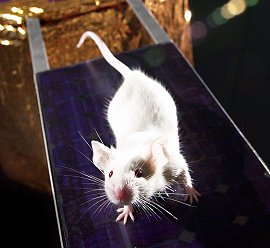AY Honors/Small Mammal Pets/Answer Key
Fancy mice ("fancy", in this context, means "hobby") are domesticated versions of the common or house mouse (Mus musculus).
Physical description
Fancy mice are approximately 16-18 cm long from nose to the tip of the tail, and weigh about 35 g for females and 50 g for males. As fancy mice have a different process of natural selection than their wild cousins, they come in a variety of colors and patterns. Most fancy mice tend to be black, brown, or white in their primary color, but others (blue, champagne, white-albino, chocolate, cream, dove, fawn, lilac, red, silver, or cinnamon) in color are available. Female mice are called does and males are called bucks.
Mice as pets
Mice are kept as pets in many countries for a number of reasons. Fancy mice are small, inexpensive, clean, and generally have a good temperament. Female mice are more popular with many owners since they tend to cohabitate with other mice better than males. Additionally, the urine of female fancy mice does not contain as strong of an odor as that of the male mice. Bucks will fight with each other, unless they were introduced at a very young age, and they produce urine with a strong, musky smell. Some people, however, prefer the personality and curiosity of male mice. It is a good idea to keep fancy mice in pairs if possible, since they are sociable animals. However, if a buck and a doe of breeding age are put in the same cage they will keep reproduce every three weeks until separated.
Mice should be kept in well-ventilated areas. Fish tanks or cages with bars and plastic flooring make good housing. The best products for in-cage bedding are aspen wood shavings, dried corn cob, or a commercial paper-based material. Mice can also be given newspaper with black-and-white printing for nesting. Small hide-aways and toys (such as a cardboard tube) are also good to have in the cage.
Food for fancy mice is relatively inexpensive. Veterenarians generally recomend a product called lab block, a scientifically-formulated blend originally desinged for mice in laboratories. Dry dog food is another good option when lab block is unavailable, as it offers balanced nutrition for a mouse and helps keep their teeth conditioned. In order to keep variety in their diets, mice can also eat oats, oily seeds, clean egg shell, breakfast cereal, and stale bread. They should also have clean water at all times and some sort of chewing wood in order to keep their teeth from growing too long.
Cat owners must also take special precautions to ensure that the mouse's housing is secure, as even the friendliest of domestic cats have been known to torment or kill fancy mice if given the chance.
Breeding mice
Bucks and does should be housed in separate enclosures until you want to breed. When the time comes you can place them together. When they have mated remove the male to stop him from remating with the female or harming the young. Several does can have their young together; they will keep all their young in one place. The young mice will suckle the mother, then wean onto solids. Then it is a good idea to move them into two separate cages, one for males and the other for females, at 5 weeks old. Make sure bucks have contact with other male mice, not only their siblings, or they may not be able to live with older males later on.
Mice clubs
Many fancy mice clubs have been set up around the globe. Shows are also held so owners can display their mice. See External links below.


